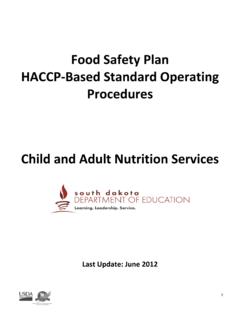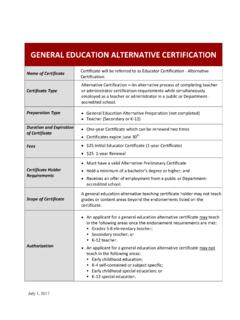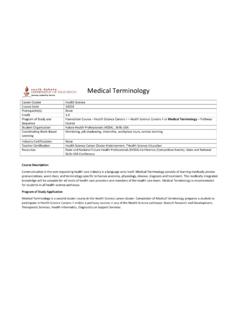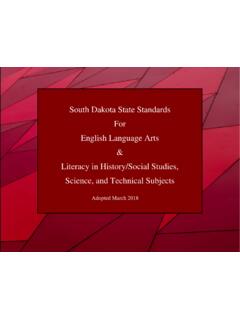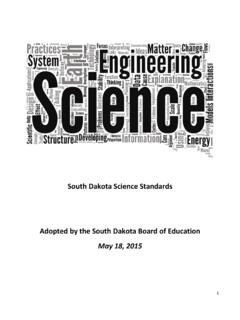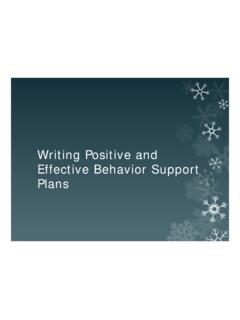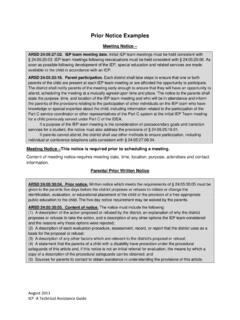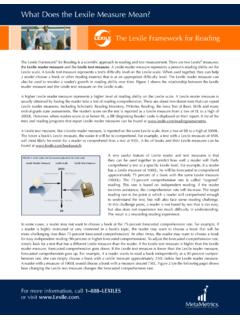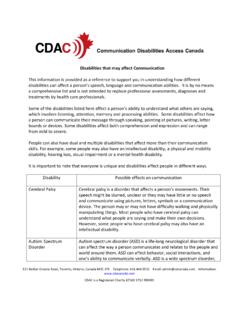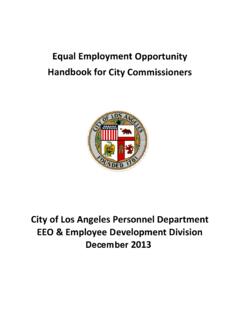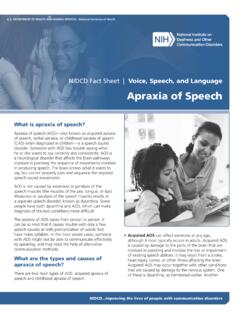Transcription of South Dakota Eligibility Guide
1 Eligibility Guide Revised AUGUST 2016 1 | Page SD Eligibility Guide TABLE OF CONTENTS CONTENTS Evaluation Procedures .. 2 Disability Categories .. 4 DEAF-BLINDNESS-500 .. 4 EMOTIONAL DISTURBANCE-505 .. 4 COGNITIVE DISABILITY-510 .. 5 HEARING LOSS-515 .. 5 SPECIFIC LEARNING DISABILITY-525 .. 6 MULTIPLE DISABILITIES-530 .. 9 ORTHOPEDIC 9 VISION LOSS-540 .. 10 DEAFNESS-545 .. 10 SPEECH OR LANGUAGE IMPAIRMENT-550 .. 11 OTHER HEALTH 13 AUTISM SPECTRUM DISORDER-560 .. 14 TRAUMATIC BRAIN INJURY-565 .. 16 DEVELOPMENTAL DELAY-570 .. 16 Related Services 17 RELATED SERVICES OF OCCUPATIONAL THERAPY .. 17 AND PHYSICAL THERAPY .. 17 IEP TEAM OVERRIDE .. 18 Resources .. 18 Appendix A .. 19 Background Information.
2 19 2 | Page SD Eligibility Guide EVALUATION PROCEDURES ARSD 24:05:25:04 Evaluation procedures. States that school districts shall ensure, at a minimum, that evaluation procedures include the following: (1) Tests and other evaluation materials are provided and administered in the child's native language or by another mode of communication that the child understands, unless it is clearly not feasible to do so. Any standardized tests that are given to a child: (a) Have been validated for the specific purpose for which they are used; and (b) Are administered by trained and knowledgeable personnel in conformance with the instructions provided by their producer; (2) Tests and other evaluation materials include those tailored to assess specific areas of educational need and not merely those which are designed to provide a single general intelligence quotient.
3 (3) Tests are selected and administered so as best to ensure that a test administered to a child with impaired sensory, manual, or speaking skills accurately reflects the child's aptitude or achievement level or whatever other factors the test purports to measure, rather than the child's impaired sensory, manual, or speaking skills except where those skills are the factors which the test purports to measure; (4) No single procedure is used as the sole criterion for determining Eligibility or an appropriate educational program for a child; (5) A variety of assessment tools and strategies are used to gather relevant functional and development information about the child, including information provided by the parents, that may assist in determining: (a) Whether the child is a child with a disability; and (b) The content of the child's IEP, including information related to enabling the child: (i) To be involved in and progress in the general curriculum; or (ii) For a preschool child, to participate in appropriate activities; (6) Technically sound instruments, assessment tools, and strategies are used that: (a) May assess the relative contribution of cognitive and behavioral factors, in addition to physical or developmental factors.
4 And (b) Provide relevant information that directly assists persons in determining the educational needs of the child; (7) The child is assessed in all areas related to the suspected disability, including, as applicable, health, vision, hearing, social and emotional status, general intelligence, academic performance, communicative status, and motor abilities; 3 | Page SD Eligibility Guide (8) The evaluation is sufficiently comprehensive to identify all of the child's special education and related services needs, whether or not commonly linked to the disability category in which the child has been classified; (9) Materials and procedures used to assess a child with limited English proficiency are selected and administered to ensure that they measure the extent to which the child has a disability and needs special education, rather than measuring the child's English language skills; and (10) If an assessment is not conducted under standard conditions, a description of the extent to which it varied from standard conditions ( , the qualifications of the person administering the test, or the method of test administration) must be included in the evaluation report.
5 ARSD24:05:25:05. Eligibility and placement procedures. In interpreting evaluation data for the purpose of determining Eligibility and determining the educational needs of the child, in making placement decisions, including decisions regarding preschool children, each school district shall do the following: (1) Draw upon information from a variety of sources, including aptitude and achievement tests, parent input, teacher recommendations, physical condition, social or cultural background, and adaptive behavior; (2) Ensure that information obtained from all of these sources is documented and carefully considered; (3) Ensure that the placement decision is made by a group of persons, including persons knowledgeable about the child, the meaning of the evaluation data, and the placement options; (4) Ensure that the placement decision is made in conformity with the least restrictive environment rules in chapter 24:05:28; and (5) Ensure that the parents of each child with a disability are members of any group that makes decisions on the educational placement of their child.
6 If a determination is made that a child is disabled and needs special education and related services, an individual education program must be developed for the child in accordance with this article. 4 | Page SD Eligibility Guide DISABILITY CATEGORIES DEAF-BLINDNESS-500 ARSD 24:05 :07. Deaf-blindness defined. Deaf-blindness means concomitant hearing and visual impairments, the combination of which causes such severe communication and other developmental and educational needs that they cannot be accommodated in special education programs solely for children with deafness or children with blindness. EMOTIONAL DISTURBANCE-505 ARSD 24:05 :16. Emotional disturbance defined. Emotional disturbance is a condition that exhibits one or more of the following characteristics to a marked degree over a long period of time: (1) An inability to learn that cannot be explained by intellectual, sensory, or health factors; (2) An inability to build or maintain satisfactory interpersonal relationships with peers and teachers; (3) Inappropriate types of behavior or feelings under normal circumstances; (4) A general pervasive mood of unhappiness or depression; or (5) A tendency to develop physical symptoms or fears associated with personal or school problems.
7 The term, emotional disturbance, includes schizophrenia. The term does not apply to a student who is socially maladjusted unless the IEP team determines pursuant to 24:05 :17 that the student has an emotional disturbance. ARSD 24:05 :17. Criteria for emotional disturbance. A student may be identified as emotionally disturbed if the following requirements are met: (1) The student demonstrates serious behavior problems over a long period of time, generally at least six months, with documentation from the school and one or more other sources of the frequency and severity of the targeted behaviors; (2) The student s performance falls two standard deviations or more below the mean in emotional functions, as measured in school and home or community on nationally-normed technically adequate measures; and (3) An adverse effect on educational performance is verified through the full and individual evaluation procedures as provided in 24:05:25:04.
8 A student may not be identified as having an emotional disturbance if common disciplinary problem behaviors, such as truancy, smoking, or breaking school conduct rules, are the sole criteria for determining the existence of an emotional disturbance. 5 | Page SD Eligibility Guide COGNITIVE DISABILITY-510 ARSD 24:05 :11. Cognitive disability defined. Cognitive disability is significantly below-average general intellectual functioning that exists concurrently with deficits in adaptive behavior skills, that is generally manifested before age eighteen, and that adversely affects a student s educational performance. The required evaluative components for identifying a student with a cognitive disability are as follows: (1) General intellectual functioning two standard deviations or more below the mean as determined by the full scale score on an individual cognitive evaluation, plus or minus standard error of measurement, as determined in accordance with 24:05:25:04; and (2) Exhibits deficits in adaptive behavior and academic or preacademic skills as determined by an individual evaluation in accordance with 24:05:25:04.
9 HEARING LOSS-515 ARSD 24:05 :10. Hearing loss defined. A student may be identified as having a hearing loss if an unaided hearing loss of 35 to 69 decibels is present that makes the acquisition of receptive and expressive language skills difficult with or without the help of amplification 6 | Page SD Eligibility Guide SPECIFIC LEARNING DISABILITY-525 ARSD 24:05 :18. Specific learning disability defined. Specific learning disability is a disorder in one or more of the basic psychological processes involved in understanding or in using spoken or written language that may manifest itself in the imperfect ability to listen, think, speak, read, write, spell, or do mathematical calculations. The term includes such conditions as perceptual disabilities, brain injury, minimal brain dysfunction, dyslexia, and developmental aphasia .
10 The term does not apply to students who have learning problems that are primarily the result of visual, hearing, or motor disabilities; cognitive disability; emotional disturbance; or environmental, cultural, or economic disadvantage. ARSD 24:05 :19. Criteria for specific learning disability. A group of qualified professionals and the parent of the child may determine that a child has a specific learning disability if: (1) The child does not achieve adequately for the child's age or does not meet state-approved grade-level standards in one or more of the following areas, if provided with learning experiences and instruction appropriate for the child's age or state-approved grade-level standards: (a) Oral expression; (b) Listening comprehension; (c) Written expression; (d) Basic reading skill; (e) Reading fluency skills; (f) Reading comprehension; (g) Mathematics calculation; and (h) Mathematics problem solving.
